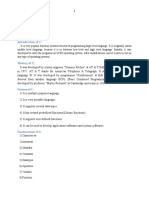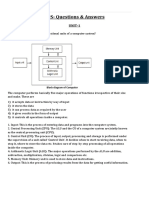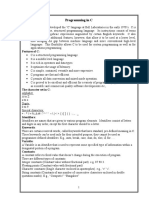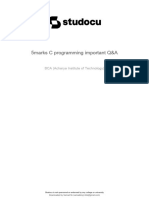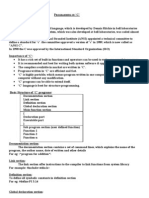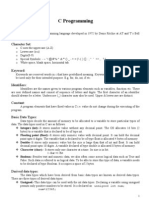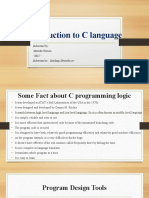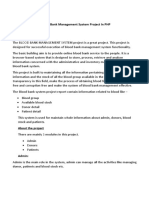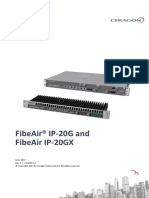CHAPTER - 2
CHARACTER SET :
A Set consist is consist of all upper case and lower case letters and a digits 0 to 9 and all type of special characters is
to used in the c is known as character set.
EXECUTION CHARACTERS:
These characters are used in the execution of the program this is also known as escape sequences.
KEY WORDS:
These are called reserved words ,it consist of 32 lower case words, each word has its own specific task these words
are called as key words.
IDENTIFIERS:
These are user defined words ,these are used to give names to variables ,arrays ,functions etc...
RULES OF IDENTIFIERS:
1.the name should contain upper and lower case letters ,letters ,digits and underscore.
2.first character should be a name or underscore.
3.the name should not be a keyword.
4.care sensitisation.
5.max 31 characters.
DATA TYPES:
The data types are reserved values ,each data type will have different values those values are stored in different
memory
(OR)
The data type is used to define or declare a variable and used for data storage format.
1.int
2.char
3.float
4.double
CONSTANTS:
The constants are the values that cannot be changed during execution of program. They are different types of
constants are they they are
1.neumaric constant
2.charactor constant
3 string constants
VARIABLES:
These are used to store the values in the memory the values will be changed during execution of program the rules
followed by variables is same as the identifiers.
�EXPRESSIONS:
An expressions are combination of the operators, constants ,variables and function cells.
STATEMENTS:
All the instructions are used in form of statements, this is a executable part of program.
CHAPTER - 3
INPUT AND OUTPUT OF C:
A set of library functions that performs input and output operations is known as standard i/o library.
In detail the main function of the program is takes data as input and process the data and gives output.
CONVERSION SPECIFICATIONS:
The functions like printf() and scanf() make use of conversion specifications to specify the type and size of data.
Ex: %c ,%d ,%o ,%f
READING INPUT DATA:
Any type of input data will be read or stores by the library function scanf().
WRITING OUTPUT DATA:
The output data will be written by a library function printf()
CHAPTER – 4
OPERATOR:
the operator performs the operation of the given expressions. They are different type of operators they
are
ARITHMETIC OPERATOR:
This operator used for all arthematic operations like addition ,subtraction ,multiplication ,division etc..
ASSIGNMENT OPERATOR:
This operator will assign the value of right hand side operand to left hand side.
INCREMENT AND DECREMENT OPERATOR:
This operator is the unary operator ,this operator operates the single operand by value one, the increment
and decrement is based on the condition.
RELATIONAL OPERATOR:
This operator is used to compare the values of two expressions.
LOGICAL OR BOOLEAN OPERATORS:
This operator will combines the two or more expressions by using logical operations.
CONDITIONAL OPERATOR:
This is also known as ternary operator, this operator is used to evaluate the given condition is true or false.
�COMMA OPERATOR:
This operator is used to separate the different expressions in the program.
SIZE OF OPERATOR:
This operator is unary operator it gives the size of operand in terms of bytes.
BITWISE OPERATOR:
Thease operator operates on bit by bit by using the AND, OR, XOR and NOT ,and this operates on integer
values only.
TYPE CONVERSION:
Thease operator will convert the one operand to another operand of different data type.
PRECEDENCE AND ASSOCIATIVITY OF OPERATORS:
This is used to evaluation of the expression having more than one operator.
CHAPTER-5
COMPOUND STATEMENTS OR BLOCKS :
A group of statements that which is enclosed by the pair of curly braces
IF :
It is the selection statement this provides execution of program only by checking the condition given in the
expression.
IF ELSE :
It is the selection statement this provides execution of a program by checking the condition of IF part ,
otherwise the else part will get execute.
NESTING OF IF ELSE :
If there is a IF ELSE statement in IF part and ELSE part then that is called as a nesting of if else.
ELSE IF LADDER :
If only ELSE part contain a IF statement then it is called as else if ladder.
WHILE, DO-WHILE, FOR :
Thease are ittarative statements this is used to execute the program of block statements for number of
times and form a loop.
NESTING OF LOOPS :
If a loop is placed in the body of a another loop then that loops are called as nesting of loops.
INFINITE LOOPS :
The loops that which execute infinite number of times and that which never terminate that is called as a
infinite loops.
�BREAK STATEMENT :
This statement is used to terminate the loop.
CONTINUE STATEMENT :
This statement is used to skip the current statement.
GO TO STATEMENT:
This statement is used to transfers the flow of one part of program to another part of program.
SWITCH STATEMENT:
It is a selection statement this provides a choice of any alternatives.
FUNCTION:
A Function is a self control sub program every program contains two or more functions if a program
contains two functions in that one function will be a main function , every program will execute in the main
function .
LIBRARY FUNCTIONS:
Thease functions are predefined functions example stdlib.h,math.h,string.h etc…..
USER DEFINED FUNCTIONS:
Programmer can create their own functions by following three main parameters. Function decleration ,
function definition , function call.
RECURSION:
A recursive function is a function that which calls itself is know as a recursion.
ARRAY:
A array is a variable that which stores one or more number of elements in a single variable with a single
data type.
POINTER:
A pointer is a variable that which stores the address of the another variable. By using pointer variable
indirect operation is preformed.
STRINGS:
A one dimentional character array is enclosed with a null character is known as a string.
STRUCTURES:
The combination of all different types of datatypes together is known as structure.
In structure every member will have its own memory allocation.
UNIONS:
Union is same as structure the only difference is all the members in the union contains only one memory
allocation and that is based on highest data type.
�STORAGE CLASSES:
The storage classes is used to describe the specifications of the variable,they are four types of storage
classes and thease are predefined words they are automatic , static , register , extern.
MEMORY MANAGEMENT:
This is used to describe the storage format of the variable in the memory.
ENUMARATION:
This is used to give the names for integers constants
TYPEDEF:
This is used to give the name for the data types , by this the readability of the program increases.


